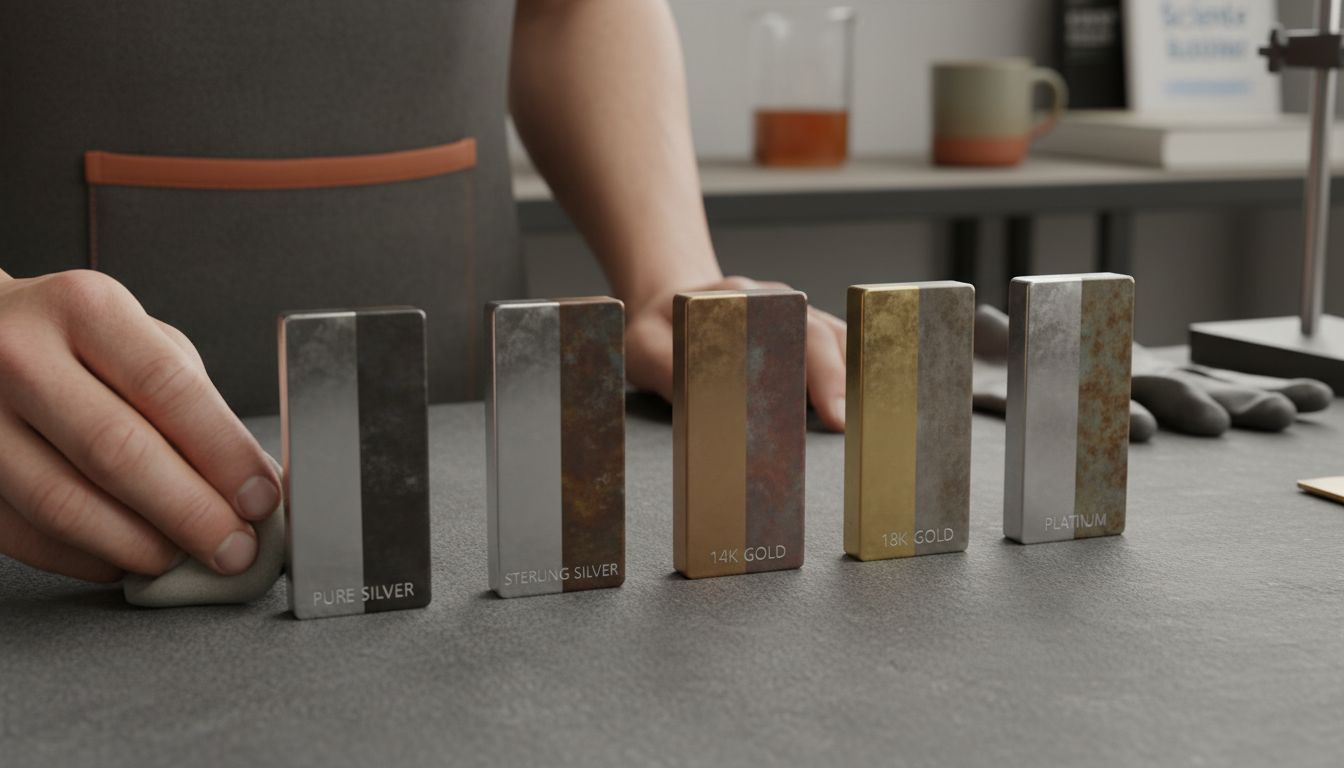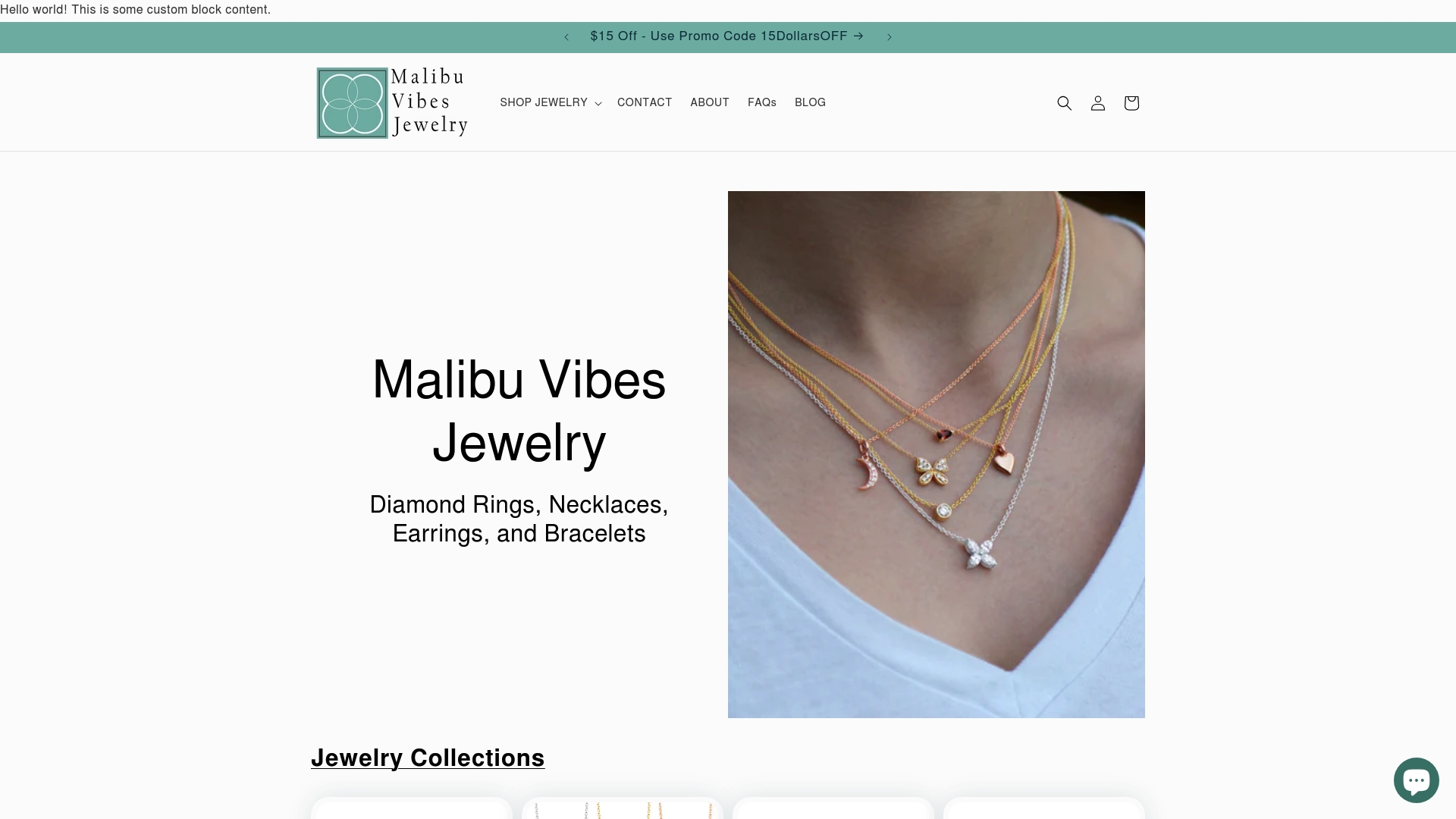Over 90% of sterling silver jewelry owners notice a dark layer form on their favorite pieces within a year. This subtle change can turn a sparkling statement piece into something that looks worn and neglected. Tarnishing affects not just the visual appeal but can also hide delicate details and lower the value of fine jewelry. By learning how metals react with their environment, you can keep your cherished accessories gleaming for years to come.
Table of Contents
- What Tarnishing Means For Fine Jewelry
- Which Metals And Alloys Are Prone To Tarnish
- Top Causes Of Jewelry Tarnishing Explained
- Environmental And Lifestyle Effects On Tarnishing
- How To Prevent And Treat Jewelry Tarnish
Key Takeaways
| Point | Details |
|---|---|
| Understanding Tarnishing | Tarnishing is a natural chemical reaction that affects fine jewelry, particularly silver, due to environmental exposure. It reduces the aesthetic appeal, necessitating proactive care. |
| Vulnerable Metals | Silver alloys, especially sterling silver, are highly susceptible to tarnishing, while metals like platinum and pure gold offer greater resistance. |
| Environmental Impact | Humidity, air pollution, and body oils significantly accelerate tarnishing. Awareness of these factors is crucial for jewelry maintenance. |
| Preventive Measures | Utilize airtight storage, regular cleaning, and professional maintenance to minimize tarnishing and preserve jewelry’s brilliance. |
What Tarnishing Means for Fine Jewelry
Tarnishing represents a natural chemical reaction that transforms the surface appearance of precious metals, particularly impacting fine jewelry pieces. According to research from Carlos Emory University, tarnishing occurs when metals like silver interact with sulfur-containing gases in the atmosphere, creating a thin, dark layer that can diminish a piece’s aesthetic appeal.
For jewelry enthusiasts, understanding tarnishing means recognizing its potential impact on your cherished pieces. The dark film that develops can obscure intricate designs, reduce shine, and make even expensive jewelry look aged or neglected. Silver and silver-based alloys are especially vulnerable, with sterling silver 925 metals being particularly susceptible to this chemical transformation.
While tarnishing might seem like a cosmetic issue, it actually signals important chemical interactions between your jewelry and environmental factors. The process doesn’t necessarily indicate poor quality but rather demonstrates the living, reactive nature of metal surfaces. Proactive care and proper storage can significantly minimize tarnishing, helping preserve your jewelry’s original luster and preventing permanent surface damage.
Key factors that accelerate tarnishing include:
- High humidity environments
- Exposure to perfumes and cosmetics
- Contact with skin oils and sweat
- Proximity to sulfur-containing substances
- Improper storage conditions
To protect your fine jewelry and minimize tarnishing, consider checking out our guide on how to store fine jewelry for expert preservation techniques.
Which Metals and Alloys Are Prone to Tarnish
Not all metals are created equal when it comes to tarnishing. According to research published in the National Institutes of Health database, alloys containing silver and copper are particularly susceptible to this chemical transformation. The specific composition and microstructure of these metals play a crucial role in determining how quickly and extensively tarnishing will occur.
Sterling silver stands out as one of the most tarnish-prone metals in fine jewelry. With its composition of 92.5% silver and 7.5% other metals (typically copper), it creates the perfect chemical environment for rapid oxidation. Gold plating offers some protection, but even gold alloys aren’t completely immune to tarnishing.
Here’s a breakdown of metals and their tarnishing characteristics:
Here’s a comparison of the tarnish resistance of popular fine jewelry metals:
| Metal | Tarnish Resistance | Key Characteristics |
|---|---|---|
| Pure Silver | Low | Tarnishes quickly |
| Sterling Silver | Low | Silver-copper alloy Vulnerable to tarnish |
| 14k Gold | Moderate | Contains alloy metals Some tarnish risk |
| 18k Gold | High | More pure gold Less likely to tarnish |
| Platinum | Very High | Extremely stable Rarely tarnishes |
- Pure Silver: Most reactive, tarnishes quickly
- Sterling Silver: High tarnish vulnerability
- 14k Gold: Moderate tarnish resistance
- 18k Gold: Better tarnish protection
- Platinum: Extremely tarnish-resistant
Interestingly, the metals most likely to tarnish are those with higher percentages of reactive elements like copper and zinc. Platinum and pure gold remain relatively stable, making them prized for their resistance to surface chemical changes.
Jewelry enthusiasts should understand that tarnishing isn’t a defect, but a natural chemical interaction between metal surfaces and environmental elements.

Top Causes of Jewelry Tarnishing Explained
According to research from Carlos Emory University, the primary culprit behind jewelry tarnishing is exposure to sulfur-containing gases in the atmosphere. These atmospheric compounds trigger complex chemical reactions that transform the surface of precious metals, creating that telltale darkened layer that can diminish the brilliance of your favorite pieces.
Environmental factors play a significant role in accelerating tarnishing. Humidity, air pollution, and even the natural oils from your skin can contribute to this chemical transformation. How to care for gold jewelry becomes crucial in mitigating these environmental impacts and preserving your jewelry’s original luster.
The most common causes of jewelry tarnishing include:
- Atmospheric Sulfur Compounds: Reacting with metal surfaces
- Humidity: Creating moisture-driven oxidation
- Body Oils and Sweat: Introducing chemical interactions
- Cosmetics and Perfumes: Containing reactive chemical compounds
- Storage Conditions: Improper environment accelerating tarnish
Understanding these causes empowers jewelry owners to take proactive steps in preservation. Different metals react differently – silver and copper-based alloys are particularly vulnerable, while platinum and pure gold remain more resistant. The key is recognizing that tarnishing isn’t a flaw, but a natural chemical process that can be managed with proper care and storage techniques.
Environmental and Lifestyle Effects on Tarnishing
According to research from the Department of Health, lifestyle factors significantly influence the rate of tarnishing in jewelry metals. Chemical exposures during manufacturing, wearing, and storage create complex interactions that can accelerate the oxidation process of precious metals.
Environmental conditions play a critical role in jewelry degradation. Humidity levels, air pollution, and even the specific climate where you live can dramatically impact how quickly your jewelry tarnishes. Sustainable jewelry practices become essential in understanding how to mitigate these environmental challenges and preserve your precious pieces.
Key environmental and lifestyle factors that contribute to tarnishing include:
- Humidity Levels: Higher moisture accelerates oxidation
- Air Pollution: Urban environments with more sulfur compounds
- Personal Chemistry: Individual body oils and sweat composition
- Workplace Exposure: Chemical environments like laboratories or industrial settings
- Storage Conditions: Improper storage can speed up tarnishing process
Understanding these factors empowers jewelry owners to make informed decisions about care and preservation. Each piece of jewelry interacts uniquely with its environment, making personalized care strategies crucial for maintaining its original brilliance and preventing premature tarnishing.
How to Prevent and Treat Jewelry Tarnish
According to research from Carlos Emory University, preventing tarnish begins with strategic storage techniques. Storing silver objects in airtight containers and using specialized tarnish-preventing fabrics can significantly reduce the oxidation process that leads to discoloration.
Treatment methods require careful consideration to avoid damaging your precious pieces. How to clean gold jewelry naturally becomes crucial in maintaining your jewelry’s brilliance without causing additional wear. Chemical research has revealed an innovative electrochemical method using aluminum foil and baking soda that can effectively remove tarnish from silver without compromising the metal’s integrity.
Preventive strategies and treatment techniques include:
- Airtight Storage: Use sealed containers with anti-tarnish strips
- Minimal Exposure: Remove jewelry before swimming or applying cosmetics
- Regular Cleaning: Gentle wiping after each wear
- Electrochemical Cleaning: Aluminum foil and baking soda method
- Professional Maintenance: Annual professional cleaning
Understanding that tarnish is a natural process helps jewelry owners approach prevention and treatment with patience and care. Each metal requires unique maintenance, so always research specific care instructions for your particular piece. The goal is preservation – protecting the beauty and value of your cherished jewelry through thoughtful, consistent care.
Protect Your Treasured Jewelry From Tarnish Today
Tarnishing can dull the beauty of your precious metals and steal the joy of wearing your favorite pieces. This natural chemical reaction especially targets metals like sterling silver and lower-karat gold, causing frustration for jewelry lovers who want lasting shine and elegance. Understanding these challenges is the first step to keeping your collection vibrant and flawless.

Explore our stunning selection of Solid Gold Necklaces crafted from high-quality metals designed to resist tarnish and maintain their brilliance. Plus, discover effortlessly stylish options from our Bezel Jewelry collection that balance durability with lasting beauty. Don’t let tarnish dim your sparkle. Visit Malibu Vibes Jewelry now to find jewelry that matches your lifestyle and promises enduring shine. Act now and enjoy expert craftsmanship alongside pieces built to stand the test of time.
Frequently Asked Questions
What causes jewelry to tarnish?
Tarnishing occurs primarily due to exposure to sulfur-containing gases in the atmosphere, as well as factors like humidity, body oils, sweat, and contact with cosmetics.
Which metals are most prone to tarnishing?
Sterling silver is particularly prone to tarnishing due to its high silver content, while other metals like copper and silver-based alloys are also vulnerable. In contrast, platinum and pure gold have very high tarnish resistance.
How can I prevent my jewelry from tarnishing?
Prevent tarnishing by storing jewelry in airtight containers, using anti-tarnish strips, minimizing exposure to moisture and chemicals, and cleaning your pieces regularly after wearing them.
What is the best method to clean tarnished jewelry?
An effective method to clean tarnished silver involves using aluminum foil and baking soda in an electrochemical process, which removes tarnish without damaging the metal. Regular gentle cleaning is recommended to maintain jewelry brilliance.
Recommended
- How to Store Fine Jewelry: Keep It Safe and Beautiful – Malibu Vibes Jewelry
- Understanding Why Invest in Gold Jewelry: A Comprehensive Guide – Malibu Vibes Jewelry
- How to Care for Gold Jewelry: Your Ultimate Guide – Malibu Vibes Jewelry
- What is Sterling Silver? Understanding Its Value and Uses – Malibu Vibes Jewelry



